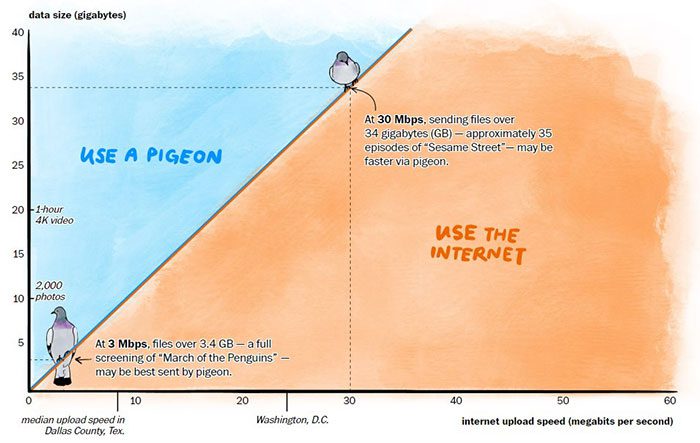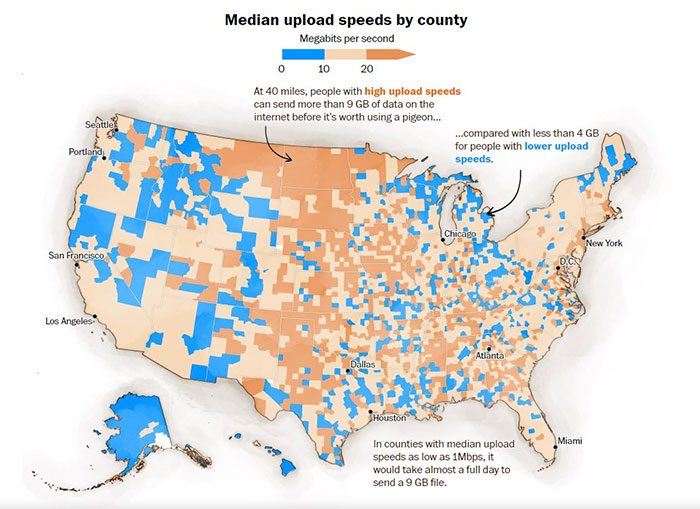Depending on the volume of data and a certain distance, pigeons are considered a faster and more suitable option for sending data in the vast rural areas of the United States.
Internet speed has developed rapidly since the era when the world was still using dial-up modems. However, sometimes even the Internet in 2023 cannot outperform carrier pigeons – a method of sending “data” that has been utilized for thousands of years.
Historically, ancient Greeks used pigeons to announce the results of the Olympic Games. In 1850, the Reuters news agency utilized 45 pigeons to send news and stock prices over a distance of 146 kilometers between Brussels and Aachen, Germany, with each trip taking 2 hours.
According to the American Racing Pigeon Union, pigeons used for messaging have an average flying speed of 64 km/h and can fly up to 643 km. In ideal weather conditions (such as with a tailwind), pigeons can reach speeds of up to 177 km/h and fly distances of up to 1600 km.
With such impressive “specifications,” pigeons can indeed outperform fiber-optic Internet, as long as they carry a sufficiently large amount of data. This was the result of an experiment conducted by technology YouTuber Jeff Geerling last August.
In this experiment, the YouTuber attached a USB stick containing 3TB of data to a pigeon’s leg to send it to a predetermined location one mile away, which only took one minute to fly. Even when adding the time required to transfer 3TB of data from the USB to a computer, the pigeon’s performance still surpassed that of fiber-optic Internet, which was not fast enough to transmit such a large amount of data in a short time.
This experiment also yielded many interesting conclusions. According to a chart measured by YouTuber Jeff Geerling, using pigeons to transfer data would be the optimal solution for distances ranging from 1 to 1000 km compared to using fiber-optic Internet.

Assuming you are sending something 100 miles away: At a speed of 3 Mbps, files larger than 3.4 GB are best sent via pigeon. At a speed of 30 Mbps, sending a 34GB file is also faster with pigeons.
In fact, depending on the volume of data and a certain distance, pigeons are even considered a faster and more suitable option for sending data in the vast rural areas of the United States, where Internet speeds can lag far behind the national average, according to the Washington Post.
Pigeons are the optimal choice for Internet users in rural America
While more and more Americans are using high-speed Internet connections, the same cannot be said for rural areas, where Internet access is unstable and very slow. In 2020, 1 in 5 rural residents were using Internet service that did not meet the minimum standards set by the FCC in 2015, which required download speeds of at least 25 Mbps and upload speeds over 3 Mbps.
Internet speeds below this threshold allow a maximum of two users to access and perform basic tasks like browsing the web, sending emails, or watching HD videos. However, the mentioned speeds are completely insufficient for tasks that require high bandwidth, such as streaming 4K video or using complex software running in the cloud.
So, what causes the Internet speed in rural America to be so slow? According to Alex Kelley, head of the broadband consulting department at the Center on Rural Innovation, the disparity between rural and urban Internet quality still exists due to uneven investments from service providers, primarily driven by the income levels of residents.

Map showing average upload speeds by county in the U.S. Areas with upload speeds as low as 1 Mbps (blue) would take nearly a day to upload a 9GB file.
Thus, Internet service providers “will invest in the best technology in areas with competitive environments and will invest in the latest technologies in wealthier areas,” Kelley stated.
In comparison, residents in certain cities have upload speeds exceeding 100 Mbps. Meanwhile, in some rural areas of the U.S., the average upload speed is only 1 Mbps. With such slow speeds, even sending a video over the Internet to someone living in the same locality would take longer than sending it via pigeon.
It is also worth noting that top technology companies like Amazon and Google do not use the Internet to transfer large amounts of data. Instead, these companies turn to a more reliable form of transport: trucks.
In 2016, Amazon launched AWS Snowmobile, a shipping container that can hold up to 100 petabytes of data – equivalent to 20 billion high-resolution photos on an iPhone. Even with the fastest possible Internet speeds, uploading 100 petabytes would take decades. In contrast, transporting that amount of data across the country by truck would only take a few days.





















































